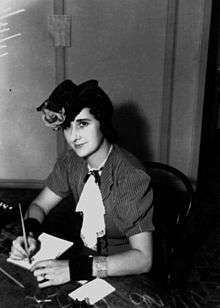Doll hat

A doll hat (sometimes doll's hat) is a women's millinery design scaled down to suggest a hat that could be worn by a doll.[1] It can be of any design and is generally worn at the front of the head.[2] The hat is usually held in place with a band of fabric or elastic secured at the back of the head.[1]
Origins of the hat
The doll hat had periods of popularity in both the 18th and 19th centuries.[3] This was an era of elaborate hairstyles and the hat was a decorative accessory rather than serving a practical function.

Doll hats became popular again in the 1930s. A report in The Times in 1937 on the latest London millinery described a miniature bonnet as among the key introductions: "A hat that looks like a doll's hat has been made of Leghorn; the floral topknot of the evening translated, as it were, into daytime wear. It needs only ribbon strings to reproduce the young matron's bonnet of the Victorian era".[4] As with earlier version of the hat, this was a decorative style suited to occasion wear. A fashion report in 1938 described an Edwardian-style model of indigo blue feathers decorated with a winged bird as ideal for: "grander occasions or the theatre".[5]
Later that year, the paper reported a new fashion for vivid doll hats in fuchsia, violet or Florentine blue worn with all-black outfits. The paper added that when a black doll hat was chosen, it should have a contrasting veil in a bright shade such as blue or pink matched with the same hue in gloves or buttonhole.[6]
The popularity of miniature hat continued into World War II. In the United States, the absence of imports from French milliners inspired American designers to innovate. Variations on the beret, bowler and boater were introduced – along with forward tilted miniature hats. Although American Vogue magazine warned its readers in 1941 that doll hat designs were: "definitely not for the unselfconfident", the design became very popular during the war years.[7]
Variations
While many versions of the doll hat replicated traditional straw hats in miniature, variations included scaled down witches' hats and Welsh hats.[8]
See also
References
- 1 2 Brooks Picken, Mary (2010). A Dictionary of Costume and Fashion: Historic and Modern (1999 ed.). United States: Dover Publications. pp. 98, 163. ISBN 0486402940. Retrieved 8 January 2015.
- ↑ "Hat Shaper's Hat Dictionary". hatshapers.com. Hat Shaper's. Retrieved 8 January 2015.
- ↑ Walford, Jonathan. "History of Hats for Women: Halo Halo". vintagefashionguild.org. Vintage Fashion Guild. Retrieved 8 January 2015.
- ↑ "London Fashions: New Spring Hats" (47611). The Times. 17 February 1937.
- ↑ "Shopping News in Brief" (48127). The Times. 17 October 1938.
- ↑ "Challenging the Supremacy of Black" (48153). The Times. 16 November 1938.
- ↑ Delis Hill, Daniel (2007). As Seen in Vogue: A Century of American Fashion in Advertising. Texas, US: Texas Tech University Press. p. 170. ISBN 0896726169. Retrieved 8 January 2015.
- ↑ "Round the shops: gift suggestions for Christmas" (48163). The Times. 28 November 1938.